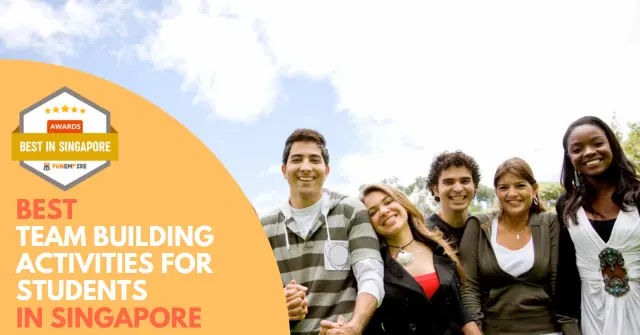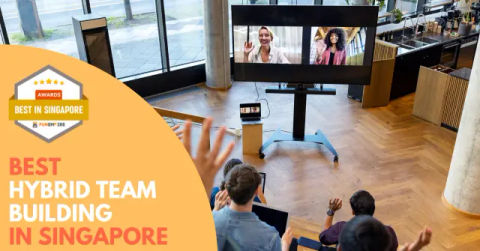Team Building Activities For Students Singapore

Team building is a crucial aspect of student development, fostering collaboration, problem-solving, and communication skills.
The best team building activities for students in Singapore include Spaghetti Tower, Shrinking Classroom, Over the Electric Fence, The Human Knot, and Bob the Builder.
In Singapore, there are numerous team activities that offer a perfect blend of fun and learning.
Whether you’re a teacher, club advisor, or student leader, organizing engaging favourite team building activities can bring your entire team closer and create memorable experiences.
In this article, we explore exciting team building activities perfect for students in Singapore, offering chances for personal growth and fostering strong relationships.
Quick Summary
- Best team building activities for students in Singapore include Spaghetti Tower, Shrinking Classroom, Over the Electric Fence, The Human Knot, and Bob the Builder.
- When choosing an exciting team building activity for students, consider factors such as team size, time, and budget.
- The goal of team activities is to foster collaboration, problem-solving, communication skills, and ultimately academic success.
Best Team Building Activities For Students In Singapore
1. Spaghetti Tower
Teams are given a limited amount of uncooked spaghetti and marshmallows. The objective is to construct the tallest freestanding tower using only these materials. Participants must strategize, design, and build their towers within a set time frame.
Mechanics:
- Participants must brainstorm ideas and allocate roles within their teams, such as builders, planners, and quality control.
- Teams must collaborate effectively to determine the structure and stability of their towers.
- Creativity is encouraged as teams experiment with different construction techniques and configurations.
Pros
- Encourages teamwork and creativity.
- Provides a hands-on learning experience.
- Requires minimal resources.
Cons
- Cleanup may be messy.
- Towers may collapse easily.
- Some participants may struggle with delicate materials.
2. Shrinking Classroom
Participants imagine themselves in a “shrinking classroom” where the space gradually decreases in size. Teams must work together to adapt and fit into the shrinking area. The fun team building activity fosters collaboration and communication as teams strategize to accommodate everyone within the diminishing space.
Mechanics:
- Teams must communicate effectively and coordinate their movements to adjust to the shrinking space.
- The facilitator announces the shrinking dimensions at intervals, adding a sense of urgency to the activity.
- Participants must use problem-solving abilities to rearrange themselves creatively within the shrinking boundaries.
Pros
- Promotes teamwork and adaptability.
- Encourages quick thinking and strategy.
- Requires minimal setup.
Cons
- May cause discomfort for some.
- Success may rely on physical abilities.
- Requires supervision for safety.
3. Over the Electric Fence
Teams face the challenge of navigating through an “electrified” area without touching the ground. Various obstacles represent the electric fence, and participants must find creative ways to overcome them. The activity promotes teamwork, problem-solving, and physical coordination.
Mechanics:
- Participants must strategize and plan their route carefully to avoid touching the ground.
- Teams may use props such as ropes, cones, or mats to create safe pathways over the “electric fence.”
- Facilitators can introduce additional challenges or rules, such as time limits or restricted movement, to increase the difficulty level.
Pros
- Promotes teamwork and creativity.
- Provides a fun physical challenge.
- Can be adapted to various settings.
Cons
- Requires space and safety precautions.
- May be challenging for some participants.
- Requires careful supervision.
4. The Human Knot
Participants stand in a circle and each person randomly grabs the hand of someone across from them. The objective is to untangle the human knot without letting go of each other’s hands. This fun team bonding activity encourages teamwork, communication skills, and problem-solving as participants work together to unravel the knot.
Mechanics:
- Participants must communicate effectively and collaborate to find the most efficient way to untangle the knot.
- Problem-solving abilities are essential as teams experiment with different strategies and movements.
- Leadership may emerge as individuals take charge or offer guidance to facilitate the untangling process.
Pros
- Promotes teamwork and problem-solving.
- Encourages trust and cooperation.
- Requires no additional materials.
Cons
- Success depends on group dynamics.
- Some may feel uncomfortable with physical contact.
- Progress can be slow or frustrating.
5. Bob the Builder
Teams are given a set of construction materials, such as building blocks or Legos, and a specific challenge to complete within a time limit. Participants must collaborate to design and build a structure that meets the given criteria. This activity fosters creativity, teamwork, and problem-solving skills.
Mechanics:
- Teams brainstorm ideas and allocate roles, such as builders, designers, and project managers.
- Participants must communicate effectively to coordinate their efforts and ensure the successful completion of the construction challenge.
- Creativity and innovation are encouraged as teams experiment with different designs and construction techniques.
Pros
- Encourages teamwork and creativity.
- Develops problem-solving and critical thinking.
- Provides hands-on learning.
Cons
- Requires sufficient materials.
- Cleanup may be necessary.
- Success depends on effective collaboration.
6. Blanket Switch
Participants stand on a blanket or tarp, holding onto its edges. Without stepping off the blanket, the group must flip it over completely, so everyone ends up standing on the opposite side. This activity requires coordination, communication, and teamwork to achieve the goal while staying on the blanket.
Mechanics:
- Participants must strategize and coordinate their movements to flip the blanket without anyone stepping off.
- Communication is key as participants signal when to lift and flip the blanket, ensuring everyone stays together.
- Problem-solving skills come into play as teams adjust their strategy based on the size of the group and the characteristics of the blanket.
Pros
- Promotes teamwork and coordination.
- Encourages creative problem-solving.
- Requires minimal setup.
Cons
- Physical strength may be necessary.
- Communication breakdowns can occur.
- Participants must avoid tripping.
7. Obstacle Run
Teams navigate through a series of obstacles, such as cones, ropes, and hurdles, to reach the finish line. The activity promotes teamwork, communication skills, and physical fitness as participants support each other to overcome challenges and complete the course.
Mechanics:
- Participants must work together to plan their approach to each obstacle, utilizing each team member’s strengths and skills.
- Communication is essential for coordinating movements and providing encouragement and support to teammates.
- Problem-solving skills are tested as teams strategize how to overcome obstacles efficiently and safely.
Pros
- Promotes teamwork and physical fitness.
- Encourages problem-solving and strategic thinking.
- Builds camaraderie and trust.
Cons
- Requires space and equipment.
- Safety precautions are essential.
- Some obstacles may be challenging.
8. Get on the Chair
Teams must work together to get every member onto a single chair without anyone touching the floor. This activity requires creativity, cooperation, and problem-solving as participants devise strategies to achieve the goal while adhering to the rules.
Mechanics:
- Participants strategize and plan their approach to getting everyone onto the chair, considering factors such as weight distribution and stability.
- Communication is crucial for coordinating movements and ensuring everyone’s safety throughout the activity.
- Creativity and innovation come into play as teams experiment with different techniques and solutions to overcome the challenge.
Pros
- Encourages teamwork and creativity.
- Develops problem-solving skills.
- Provides a fun challenge.
Cons
- Success depends on physical abilities.
- Safety precautions are necessary.
- Communication breakdowns can occur.
9. Classroom Party
Participants are divided into teams and given a limited budget to organize a classroom party. Teams must collaborate to plan the party, including selecting a theme, decorating the space, and arranging refreshments and entertainment. The activity fosters teamwork, creativity, and budgeting skills.
Mechanics:
- Teams must work together to allocate their budget effectively, balancing expenses for decorations, food, and entertainment.
- Communication is essential for coordinating tasks and ensuring that everyone’s ideas are considered in the party planning process.
- Problem-solving skills are tested as teams overcome challenges such as limited resources or conflicting preferences.
Pros
- Promotes teamwork and creativity.
- Encourages budgeting skills.
- Builds camaraderie and celebrates achievements.
Cons
- Requires planning and resources.
- Success depends on effective collaboration.
- Participants must manage budget constraints.
10. Escape the Classroom
Teams are “locked” in a classroom and given a series of puzzles, riddles, and challenges to solve within a set time limit. The objective is to unlock the door and escape the room before time runs out. The activity promotes teamwork, critical thinking, and problem-solving under pressure.
Mechanics:
- Teams must collaborate to solve each puzzle or challenge, using their collective knowledge and skills to progress.
- Communication is essential for sharing ideas, coordinating efforts, and keeping track of time throughout the activity.
- Creativity and lateral thinking are encouraged as teams approach each challenge from different perspectives and explore various solutions.
Pros
- Promotes teamwork and critical thinking.
- Provides a thrilling and immersive experience.
- Encourages collaboration and camaraderie.
Cons
- Requires planning and preparation.
- Success may depend on familiarity with puzzles.
- Participants must manage time effectively.
Team Building Activities For Students Singapore
Team activities for students are invaluable tools that foster collaboration, enhance problem-solving abilities, and build stronger connections among peers.
Through a variety of challenges ranging from physical tasks to strategic planning and creative problem-solving, students learn to combine their strengths, communicate effectively, and work together towards common goals.
Implementing these activities within the educational environment not only breaks the monotony of traditional learning but also prepares students for real-world interactions and collaborations.
By investing time in team building, educators can cultivate a classroom atmosphere rooted in mutual respect, understanding, and unified effort, setting the stage for a more productive and inclusive learning experience.
Frequently Asked Questions (FAQs)
If you have any questions about cool Team Building Activities For Students in Singapore, you can refer to the frequently asked questions (FAQ) about the Team Building Activities For Students in Singapore below:
What age groups are suitable for these team-building activities?
These activities are designed to be adaptable for a wide range of age groups, from elementary school students to college-age individuals. With slight modifications, each activity can be tailored to suit the physical abilities and interests of different age groups.
How can I modify these activities for a small classroom space?
Many of these activities can be scaled down or modified to fit smaller spaces. For instance, “Obstacle Run” can be organized with smaller, portable obstacles, and “Escape the Classroom” puzzles can be designed to be more intellectual than spatial.
Do these activities require special equipment?
While some activities, like “Obstacle Run,” might require specific items such as cones or ropes, others, like “Escape the Classroom” or “Classroom Party,” mostly require common classroom materials or objects easily found at home.
How do I ensure the safety of participants during physically demanding activities?
Ensure that all activities are supervised by adults who can enforce safety rules, check the equipment before use, and modify activities to suit the participants’ physical capabilities. Provide safety gear if necessary, and always have a first aid kit on hand.
Can these team-building activities be conducted virtually?
Many of these activities can be adapted for a virtual setting with a bit of creativity. For example, “Classroom Party” could involve planning a virtual theme party, while “Escape the Classroom” can be turned into solving digital puzzles as a team over a video call.
What are some examples of a team building activity suitable for students in Singapore?
Team activities for students in Singapore can vary widely, ranging from outdoor adventure challenges to indoor problem-solving games. Some popular options include cooking team building activities, team building games, and collaborative projects that require the whole team’s participation.
How can team bonding activities benefit highly energetic teams of students?
Team bonding activities provide an outlet for energetic teams of students to channel their enthusiasm into productive collaboration. By engaging in a fun and interactive game, students can develop teamwork skills, improve communication, and learn to focus their energy towards common goals.
Are there specific team building events tailored for students in Singapore?
Yes, there is team building event specifically designed for students in Singapore. These events often incorporate elements of adventure, creativity, and learning to provide an engaging experience for young participants. From outdoor expeditions to indoor workshops, students can explore various corporate team building activities adapted to their age group and interests.
What are the benefits of incorporating a cooking team building activity into student programs?
Cooking team building activity offers a unique opportunity for students to collaborate, communicate, and problem-solve in a hands-on environment. By working together to prepare meals or snacks, students can strengthen bonds, foster creativity, and learn valuable life skills while having fun as a whole team.
How can educators ensure the success of team bonding activities for students in Singapore?
To ensure the success of team bonding activities for students in Singapore, educators should carefully select activities that align with students’ interests, abilities, and learning objectives. Additionally, providing clear instructions, fostering a positive and inclusive atmosphere, and facilitating meaningful reflection can enhance the overall experience for participants.







